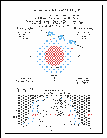|
- - text and links as of last publication - -
August 6th, 2009 Penumbral Lunar EclipseThis third lunar eclipse in 2009 still is a partial penumbral one, and still a relatively dim one. This time, the Moon is partially passing only in the North of the Earth's penumbra, leading to that the phenomenon will have to be searched in the southern part of the Moon. There is a penumbral lunar eclipse occurring when the Moon, instead of being attained by the Earth's umbra, the darker of the Earth's shadow, is just affected, at the opposite, by the Earth's penumbra, the lighter part of the shadow. From the Moon, there would be a partial solar eclipse only. for more about Moon eclipses, theoretically, see our tutorial: Moon Eclipses A penumbral Moon eclipse is less spectacular than a total or partial one, as the dimming of the Moon may be harder to observer. It's a good show, worth the observation however albeit the geometry of this one might, albeit in a lesser measure than for the one in July, render that relatively more difficult. The whole of the eclipse is observable, this time, from Scandinavia to the whole of Africa, the Near-East and to most of South America (some coastal margins, northwest, excepted). Iceland too is in the show. The two-thirds of North America, and central America have the eclipse en cours as the moon is rising, as countries lying from eastern Scandinavia to the Middle East, Central Asia, India and somewhere about Thailand are having the eclipse interrupted by moonset, on the other hand. Eastern Asia and Russia, Japan, Australia, Indonesia, Alaska and the northwestern parts of North America do not any eclipse at all The eclipse's main data are the following (data as of beginning of July 2009). for more about how to observe a lunar eclipse, see our tutorial "Observing a Moon Eclipse":
. for more about this eclipse and for more about solar and lunar eclipses generally, see Fred Espenak's NASA Eclipse Web Site Observation Reports: no observation reports
Website Manager: G. Guichard, site 'Amateur Astronomy,' http://stars5.netfirms.com. Page Editor: G. Guichard. last edited: 12/28/2010. contact us at ggwebsites@outlook.com |


